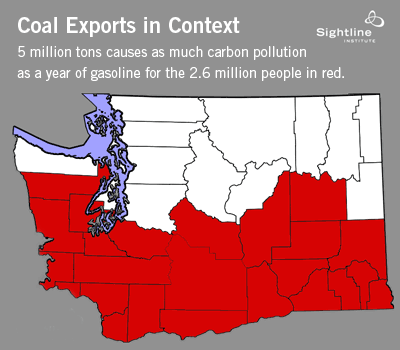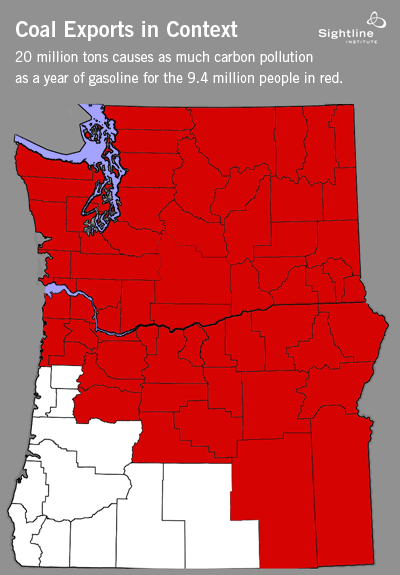There’s a heated controversy over plans for Washington state ports to ship large volumes of coal to China. In fact, last week we learned that the coal companies had been lying to the small community of Longview, Washington.
In a proposal put forward to county commissioners and state officials, the company outlined plans for an export terminal that would handle around 5 million tons of coal annually. That’s a lot of coal. It raised eyebrows—and some meaningful opposition—in the town. And while it’s true that most of the concern in Longview wasn’t about carbon emissions, it’s worth taking a moment to assess the scale of the climate consequences.
When burned, 5 million tons of coal will release as much climate-changing carbon pollution as all the gasoline burned in a year by 2.6 million residents of Washington. For visual types, here’s a depiction:

Yet it turns out that 5 million tons of coal isn’t even half the story.
A legal appeal found internal company documents showing that the company was actually planning something much, much larger. In fact, company officials pretty clearly were aiming to build a huge 20 million ton export facility.
When burned, 20 million tons of coal will release as much climate-changing carbon pollution as all the gasoline burned in a year by 9.4 million residents of Washington and Oregon. Once again, for visual types: 
And that’s not the half of it. Internal memos now reveal that company officials were secretly discussing plans for a 60 million ton mega-export facility—the largest in the US—designed to move staggering volumes of Rocky Mountain coal to Asian markets, particularly China.
It’s genuinely hard to grasp just how much pollution that kind of coal would cause. For some context, when burned, 60 million tons of coal will release as much climate-changing carbon pollution as all the gasoline burned in a year by 27 million residents of a huge swath of the western United States. Like so:

It’s not exactly small potatoes. Exporting Powder River Basin coal to China from the West Coast may very well be the single biggest climate catastrophe that’s unfolding right now. But more on all that later.
Notes:My calculations assume that Powder River Basin coal generates 8,500 BTUs per pound, and that 1 million BTUs produces 212.7 pounds of CO2. Gasoline consumption refers to “motor gasoline” and comes from the US Energy Information Administration’s State Energy Data System, here, using 2008 figures. My calculations use the official carbon dioxide coefficients from the Department of Energy, here. For calculating and attributing gasoline carbon emissions, I used 2009 county population figures from the US Census Bureau, and I assumed that each county’s share of total state gasoline emissions are exactly proportional to its share of the state’s total population.

Comments are closed.